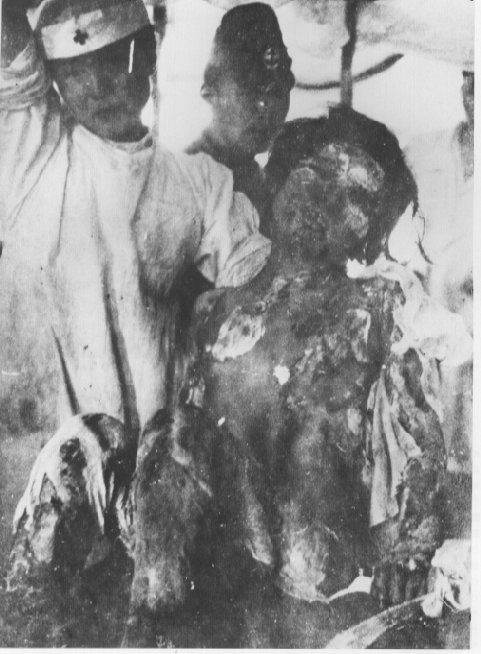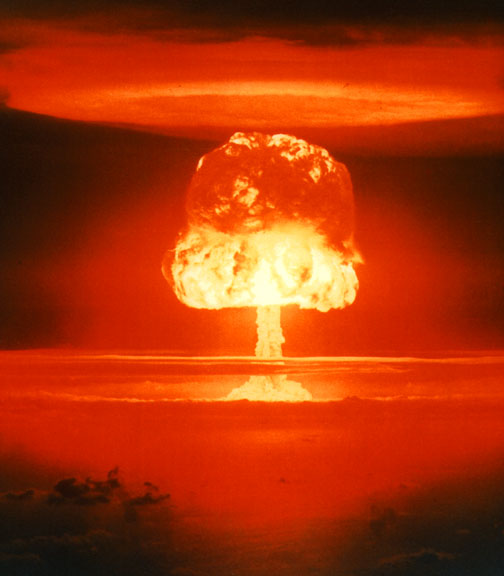
|
|
|
|
|
|
|
|
|
|
|
|
|

The
atomic bombing of Hiroshima on August 6, 1935 and of Nagasaki on August
9 devastated these two cities in Japan, and instantly killed approximately
135,000 people. Thousands others died later from injuries sustained
from the bombs and also because of radiation poisoning. This site explores
the development of the atomic bomb, what happened on the days of the bombings,
and also some of the lingering physical effects that these bombs had on
the people in Hiroshima and Nagasaki.
The atomic bomb was developed by the United States
during World War II for possible use in Europe or Asia. Many people
believe one reason for the invention of the bomb was the Japanese bombing
on Pearl Harbor in December of 1942. The atomic bomb was developed
under the code name Manhattan Project. One influential person in
the development of the bomb was Robert Oppenheimer who is often called
"the father of the atomic bomb" because he was the director of the weapon’s
laboratory where the first atom bomb was built. Most of the research
for the bomb was conducted in New York City, and the first bomb was built
in Los Alamos, New Mexico. On June 16, 1945, the detonation of the
first successful atomic bomb took place at what is called the Trinity Site
near Alamogordo, New Mexico. Two atomic bombs, called "Little Boy"
and "Fat Man" were dropped on Hiroshima and Nagasaki, respectively in 1945.
The first of the atomic bomb was dropped on the city of Hiroshima on
August 6, 1945, at 8:15 a.m. by the plane the Enola Gay. It is believed
that the target for the drop was the Aioi Bridge, which joined the east
and west sections of the city with the districts to the south. Research
has indicated, however, that the actual explosion was about 300 meters
southeast of the bridge, above Shima Hospital. The temperature of
the air where the bomb exploded reached several million degrees Celsius.
Immediately after the explosion, a fireball, which radiated white heat,
appeared and intense heat rays and radiation were released in all directions.
Thirty-five percent of the energy released by the bomb was heat rays, fifty
percent was blast wind, and fifteen percent was radiation with five percent
of this being initial radiation and the rest as residual radiation.
After the explosion, a cloud was formed by the disturbed air and was lifted
upward. As it reached the bottom of the stratosphere, the cloud spread
out horizontally reaching a diameter of several kilometers. This
cloud, often called the mushroom cap, was later dispersed by the wind.
The bomb destroyed everything within eight miles of the hypocenter and
about 80,000 people were killed instantly. Many survivors died later
from injuries or radiation poisoning.

The second bombing occurred in the city of Nagasaki, a major naval and shipbuilding center. Nagasaki was not originally going to be the target of the second bomb. The original target was Kokura, but this city could not be bombed because of cloud cover. This bombing occurred on August 9, 1945 at 11:02 a.m. The bomb dropped on Nagasaki was larger than the one dropped on Hiroshima and it was a plutonium bomb, while the one in Hiroshima was a uranium bomb. As a result, this bomb was much more explosive than the first, but the destructive effect was decreased because of the mountainous topography of the city. Because of the explosion, 6.7 million square meters of the city were leveled and 73,884 people were killed. There were 74,909 people who were injured and many more people later died from radiation poisoning.
The bomb had many physical effects on people. These include injuries due to heat and fire, blast injuries, and damage due to radiation. The radiation also complicated the heat and blast injuries by slowing the healing process in the first four to five months after the bombing. After these effects diminished, different disorders appeared which, it is believed, were caused by radiation.
The injuries due to heat rays and fire usually consisted of primary and secondary burns. Primary burns are those caused by direct exposure to the heat rays. Secondary burns are from the fires ignited by the heat rays. Often, the victims suffered both. The burns also varied in their distance from the hypocenter of the bomb. Within 1.2 km of this hypocenter, people were openly exposed to the direct heat rays and, as a result, were burned through the skin and into the tissues below. The majority of these people died immediately or within a few days. Within 2 km, the exposure led to severe burns, which incapacitated the victims. Beyond 3 km, the burns only affected the surface of the skin. Also, many people were burned to death in the fire ignited by the bomb because they were trapped under debris of the standing structures of the city, all of which were leveled.
Another type of injury caused by the explosion was blast injuries. These injuries are also categorized as primary and secondary. Primary injuries are those caused by the actual blast and secondary are those caused by falling structures. These injuries could include broken bones and cuts by being thrown through the air by the force of the blast. As the victims were thrown, their clothes were burned and blown to tatters. The skin of those who were burned was peeled away or was left hanging in strips. Also, many victims were pierced with hundred of glass fragments from the windows which were shattered. Many years later, people had fragments surgically removed from their flesh and today people still live with these fragments still embedded in their skin.
Acute radiation damage includes the effects demonstrated in the first five months after the bombings. These effects include digestive tract disorders like nausea, loss of appetite, diarrhea; nervous disorders like headaches, delirium, and insomnia; fatigue; blood in vomit, urine, stool; skin infections; fever; blood disorders; and reproductive disorders. These effects usually started with nausea and vomiting, fatigue, fever, and diarrhea. After two weeks, the victims started losing their hair.
After these acute effects had decreased, the radiation continued to produce many other physical problems. These include keloids, leukemia, cancer, and in-utero exposure. Keliods are mounds of raised and twisted flesh, which occurred when the scar tissue covering burns began to swell and grow starting in 1946. These keliods were found in fifty to sixty percent of the people burned within 2 km of the hypocenter. They caused extreme physical and emotional pain. Leukemia is a malignancy of the blood that occurs when white blood cells reproduce uncontrollably and lose their function. As a result, the victim loses resistance to disease. A third aftereffect of the radiation was cancer. In the 1960s, the occurrence of thyroid, breast, lung, and other cancers grew rapidly and radiation has been shown to have been an important factor in that growth. In-utero exposure affected fetuses exposed to the bomb while in their mothers’ wombs. Many fetuses died in the womb as a result of this exposure. Also, those who survived died at a higher rate than unexposed children. A common symptom of in-utero exposure was microcephaly, a skull whose size was smaller than normal.
The Great Depression had many significant consequences
for the country. In the political world, the economic distress led
to the election of Democrat, Franklin D. Roosevelt to the presidency in
1932. He introduced many changes in the structure of the American
economy and implemented what was called the New Deal that began many public-works
projects to decrease unemployment. The Tennessee Valley Authority
and the Public Works Administration are examples of these public works
projects. One agency that was started in response to what happened
with the stock market was the Securities Exchange Commission. This
agency enforced new security laws that made it necessary that if businesses
wanted to sell securities or stocks in their business, the owners had to
be truthful with potential investors about their companies and warn them
about the risks involved in investing. Another agency, the Agricultural
Adjustment Administration, was created in 1933 to help farmers increase
their income by reducing supply to boost prices. These are just some
of the measures taken by Roosevelt to try to get the country out of depression.
However, mass unemployment and economic stagnation continued. About
15 percent of the work force were still unemployed in 1939. When
World War II broke out in the same year, this number went down rapidly.
Workers were needed in factories to produce armaments and munitions.
The end to the Great Depression came after the United States entered the
war in 1941.
The bombings on Hiroshima and Nagasaki have had many
effects on the people of Japan as well as people all over the world.
One effect was that it, at least partially, caused the Japanese to surrender.
As stated earlier, the bombings and the radiation given off from them caused
a tremendous loss of life and amount of suffering. At one point right
after the bombings it was estimated that it would take seventy-five years
for vegetation to begin to grow again in the places where the bomb hit.
Luckily, however, this estimation was wrong.
Hersey, John. Hiroshima. New York: A.A. Knopf, Inc.,
1985.
Kurzman, Dan. Day of the Bomb: Countdown to Hiroshima.
New York: McGraw-Hill Book Company, 1986.
Lifton, Betty Jean. A Place Called Hiroshima. Tokyo:
Kodansha International Ltd., 1985.
Seldon, Kyoko and Seldon, Mark. The Atomic Bomb: Voices from
Hiroshima and Nagasaki. New York: M.E.
Sharpe, Inc., 1989.
Wyden, Peter. Day One: Before Hiroshima and After.
New York: Simon and Schuster, 1984.
Click to access another Marquette University student's report on this topic
http://www.city.hiroshima.jp/C/City/AbombDamage/00.html. Outline of Atomic Bomb Damage in Hiroshima.
http://www.csi.ad.jp/suzuhari-es/1000cranes/nagasaki/. The Atomic Bombing of Nagasaki.
http://darter.ocps.k12.fl.us/classroom/who/darter1/hirosh.htm. The Atomic Bombing of Hiroshima: A Day of Doom.
http://www.lams.losalamos.k12.nm.us/heacock/heacockss.ManhattanProject.html. The Manhattan Project.
http://www.nagasaki-gaigo.ac.jp/nagasaki/10.html.
The Atomic Bombing of Nagasaki.